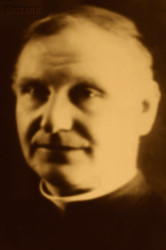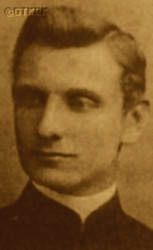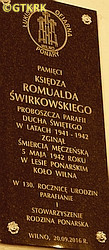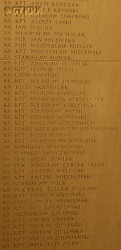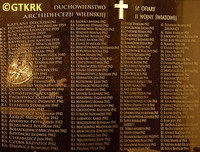Roman Catholic
St Sigismund parish
05-507 Słomczyn
85 Wiślana Str.
Konstancin deanery
Warsaw archdiocese, Poland
full list:
displayClick to display full list

searchClick to search full list by categories
wyświetlKliknij by wyświetlić pełną listę po polsku

szukajKliknij by przeszukać listę wg kategorii po polsku

Martyrology of the clergy — Poland
XX century (1914 – 1989)
personal data
surname
ŚWIRKOWSKI
forename(s)
Romualdo (pl. Romuald)
function
diocesan priest
creed
Latin (Roman Catholic) Church RCmore on
en.wikipedia.org
[access: 2014.09.21]
diocese / province
Vilnius archdiocesemore on
en.wikipedia.org
[access: 2013.05.19]
Vilnius diocesemore on
en.wikipedia.org
[access: 2013.05.19]
RC Military Ordinariate of Polandmore on
en.wikipedia.org
[access: 2014.12.20]
honorary titles
Gold „Cross of Merit”more on
Gold „Cross of Merit”
(07.12.1938)
date and place
of death
05.05.1942

Aukštieji Paneriaitoday: district of Vilnius, Aukštieji Paneriai eld., Vilnius city dist., Vilnius Cou., Lithuania
more on
en.wikipedia.org
[access: 2022.01.06]
details of death
During World War I 1914‐1918, after the Russian defeat on 02‐05.05.1915 in the Battle of Gorlice, and the withdrawal of the Russians — marked by the escape of c. 3 million Russian officials, the occupiers' administrative apparatus, teachers, soldiers, Orthodox clergy and their families, known as the bezhenstvo — several hundred kilometers to the east, the front stabilized more or less on the line Riga (Latvia) – Daugavpils (Latvia) – Baranovichi (Belarus) – Pinsk (Belarus) – Dubno (Volyn) – Ternopil (Ukraine) – Chernivtsi (Ukraine), cutting Belarus in half.
His Shchuchyn parish was occupied by the Germans and incorporated as the seat of the Germ. Kreis Planty (Eng. Planty county), within the Germ. Gebiet des Oberbefehlshabers Ost (Eng. Territory of the Commander‐in‐Chief of the East), called Ober Ost for short. The Poles — in view of the difficult financial situation and the support of the Belarusian and Lithuanian elements by the Germans — founded a Citizens' Committee in the town, which operated in the years 1915‐1917. Was its member. Despite German reluctance, it was possible to open a Polish primary school, in which was a prefect. However, the Germans forced compulsory German language lessons and propaganda teacher conferences, which were only eliminated in 1918.
And 1918 was an attempt to implement the German superpower policy in the East. On 03.03.1918 the Central Powers (Germany and Austria–Hungary) concluded a peace treaty with Bolshevik Russia, under which, among other things, the Germans started occupation basically all of Belarus. On 23.03.1918 Germany recognized the independence of Lithuania with Vilnius. On 25.03.1918 the Belarusian People's Republic is established, a political entity with basically no established borders. There was no time for further steps, because on 11.11.1918 World War I ended — Germany was defeated. The Germans began to withdraw from the east — with Bolshevik Russia entering the abandoned territories. And Poland, that on 11.11.1918 regained independece, was not allowed to interfere in this process.
In response, the Poles in Shchuchyn founded — on 13.11.1918, in a meeting at his rectory — a County Council, of which became secretary, while Fr John Moroz became its vice‐president. The tasks it set itself were to fight against Belarusian and Lithuanian agitation and to organize a Polish local armed force. A self‐defense unit was formed, which on 14.01.1919, took an oath of allegiance to the Republic of Poland in its church — became its chaplain. This took place after the Russians had occupied Vilnius — it had happened on 04‐06.01.1919, despite the resistance of Polish self‐defense, which de facto became the first phase of the Polish–Russian War of 1919‐1921. In the meantime, his county became a „no man’s land”. Till 26.01.1919, when the Polish self‐defense left Shchuchyn in search of a larger Polish unit to join, and immediately afterwards the Russians entered the town. Endless „rallies and meetings began, fiery speeches were delivered, the 'rotten West' and 'reactionary Poland' were condemned, and mountains of gold and paradise on earth were promised”. A few Poles were deported to the East, from where they never returned. However, the time had changes — on 09.02.1919 the retreating Germans allowed the Polish Army to enter Belarus. The preparation period began, which ended on c. 04.03.1919, when the Polish Army entered Shchuchyn; next captured Lida after fighting the Russians on 17.03.1919; and on 19‐21.04.1919 retook Vilnius. Poland returned to his Shchuchyn.
After German and Russian invasion of Poland in 09.1939 and start of the World War II, during Lithuanian and Russian occupation of Vilnius, representative of the diocesan Curia in Vilnius command of the Polish resistance Polish Victory Service SZP, later Armed Struggle Union ZWZ (later Home Army AK) and Regional Government Committee (part of Polish Clandestine State) under „Shield” nom‐de‐guerre.
Some of the meetings of SZP and ZWZ were held in his apartment.
After German attack on 22.06.1941 of their erstwhile ally, Russians, and capture of Vilnius by Germans, took part in efforts to help persecuted Jews — the announcement of getto opening bears the date of 06.09.1941 — providing fictitious baptism certificates and identity documents, securing shelter.
Arrested by the Germ. Geheime Staatspolizei (Eng. Secret State Police), i.e. Gestapo, on 15.01.1942.
Tortured by Lithuanians, from a murderous Saugauma and from „Paneriai riflemen” organistations, collaborating with Germans — a witness recollected: „Few days after arrest was taken for an interrogation. Came back beaten up”.
Held in single prison cell.
Murdered by Lithuanians in Paneriai extermination camp in a group of Jews and young Poles from Lukiškės prison.
At the execution site was to kneel and „started praying, turned towards the youths brought with him and made a sign of cross”.
cause of death
mass murder
perpetrators
Germans / Lithuanians
sites and events
PaneriaiClick to display the description, Vilnius (Lukiškės)Click to display the description, Help to the JewsClick to display the description, Ribbentrop‐MolotovClick to display the description, Pius XI's encyclicalsClick to display the description, Polish‐Russian war of 1919‐1921Click to display the description
date and place
of birth
20.10.1886

Petruškostoday: Švenčionys eld., Švenčionys dist., Vilnius Cou., Lithuania
more on
lt.wikipedia.org
[access: 2020.07.31]
alt. dates and places
of birth
20.09.1886
parents
ŚWIRKOWSKI Adolph
🞲 ?, ? — 🕆 ?, ?

NIEDŹWIEDZKA Mary
🞲 ?, ? — 🕆 ?, ?
presbyter (holy orders)
ordination
23.05.1909

positions held
1941 – 1942
parish priest — Vilniustoday: Vilnius city dist., Vilnius Cou., Lithuania
more on
en.wikipedia.org
[access: 2022.01.06] ⋄ Holy Spirit RC parish ⋄ Vilniustoday: Vilnius city dist., Vilnius Cou., Lithuania
more on
en.wikipedia.org
[access: 2022.01.06] RC deanery
1936 – 1941
chaplain — Vilniustoday: Vilnius city dist., Vilnius Cou., Lithuania
more on
en.wikipedia.org
[access: 2022.01.06] ⋄ Visitandines VSM ⋄ Sacred Heart of Jesus and St Francis de Sales RC church ⋄ Vilniustoday: Vilnius city dist., Vilnius Cou., Lithuania
more on
en.wikipedia.org
[access: 2022.01.06] RC deanery
1936 – 1939
secretary — Vilniustoday: Vilnius city dist., Vilnius Cou., Lithuania
more on
en.wikipedia.org
[access: 2022.01.06] ⋄ Catholic Action Diocesan Institute DIAK
1932 – 1936
dean — Slonimtoday: Slonim dist., Grodno reg., Belarus
more on
en.wikipedia.org
[access: 2021.09.29] RC deanery
1932 – 1936
parish priest — Slonimtoday: Slonim dist., Grodno reg., Belarus
more on
en.wikipedia.org
[access: 2021.09.29] ⋄ St Andrew the Apostle RC parish (main parish) ⋄ Slonimtoday: Slonim dist., Grodno reg., Belarus
more on
en.wikipedia.org
[access: 2021.09.29] RC deanery
1932 – 1936
administrator — Synkavichytoday: Synkavichy ssov., Zeľva dist., Grodno reg., Belarus
more on
en.wikipedia.org
[access: 2022.01.06] ⋄ Transfiguration of the Lord RC parish ⋄ Slonimtoday: Slonim dist., Grodno reg., Belarus
more on
en.wikipedia.org
[access: 2021.09.29] RC deanery
1930 – 1932
dean — Myorytoday: Myory dist., Vitebsk reg., Belarus
more on
en.wikipedia.org
[access: 2024.03.19] RC deanery
1927 – 1932
parish priest — Myorytoday: Myory dist., Vitebsk reg., Belarus
more on
en.wikipedia.org
[access: 2024.03.19] ⋄ Assumption of the Blessed Virgin Mary RC parish ⋄ Myorytoday: Myory dist., Vitebsk reg., Belarus
more on
en.wikipedia.org
[access: 2024.03.19] RC deanery
1912 – 1927
parish priest — Shchuchynalso: Lithuanian Shchuchyn
today: Shchuchyn dist., Grodno reg., Belarus
more on
en.wikipedia.org
[access: 2022.09.17] ⋄ Holiest Heart of Jesus and St Therese the Virgin RC parish ⋄ Lidatoday: Lida dist., Grodno reg., Belarus
more on
en.wikipedia.org
[access: 2021.09.29] RC deanery
from 1922
prefect — Shchuchynalso: Lithuanian Shchuchyn
today: Shchuchyn dist., Grodno reg., Belarus
more on
en.wikipedia.org
[access: 2022.09.17] ⋄ State Teachers' Seminary
1922
parliamentary deputy — Central Lithuania Seym — also: secretary of the presidium
1912
vicar — Vilniustoday: Vilnius city dist., Vilnius Cou., Lithuania
more on
en.wikipedia.org
[access: 2022.01.06] ⋄ All the Saints RC parish ⋄ Vilniustoday: Vilnius city dist., Vilnius Cou., Lithuania
more on
en.wikipedia.org
[access: 2022.01.06] RC deanery
1912
parish priest — Rukainiaitoday: Rukainiai eld., Vilnius dist., Vilnius Cou., Lithuania
more on
en.wikipedia.org
[access: 2022.01.06] ⋄ St Stanislav the Bishop and Martyr RC parish ⋄ Vilnius districtdeanery name
today: Vilnius Cou., Lithuania RC deanery
1911 – 1912
student — Sankt Petersburgtoday: Saint Petersburg city, Russia
more on
en.wikipedia.org
[access: 2020.07.31] ⋄ Imperial Roman Catholic Spiritual Academy (1842‐1918)
1909 – 1911
vicar — Vilniustoday: Vilnius city dist., Vilnius Cou., Lithuania
more on
en.wikipedia.org
[access: 2022.01.06] ⋄ St John the Baptist and St John the Evangelist RC parish ⋄ Vilniustoday: Vilnius city dist., Vilnius Cou., Lithuania
more on
en.wikipedia.org
[access: 2022.01.06] RC deanery — also: prefect of city school and chaplain of the „Sawicz” City Hospital
1905 – 1909
student — Vilniustoday: Vilnius city dist., Vilnius Cou., Lithuania
more on
en.wikipedia.org
[access: 2022.01.06] ⋄ philosophy and theology, Theological Seminary
others related
in death
MOROZClick to display biography John, KISIELClick to display biography Vladislav, OGANOWSKIClick to display biography Francis, WĘCKIEWICZClick to display biography Peter
sites and events
descriptions
Paneriai: In 1941‐1944 in Paneriai (also: Ponary) n. Vilnius Germans murdered c. 100,000 victims, among them 60‐70% Polish Jews and 20% Poles, mainly from intelligentsia, including professors of Stephen Batory University in Vilnius and Polish priests. Executions were carried out mainly by Lithuanian Ypatingasis būrys units, known as Ponary riflemen. The victims were brought on trains or marched on foot from Vilnius. Then they were executed — in stages. Some were forced to wait a dozen or so hours or even days. In the meantime Ponary riflemen beat them up with rubber battons and set dogs on them. Every dozen or so minutes another party of victims were marched into the compound, forced to undress and step into a pre‐dug ditch. From there, in group of 10‐12, were dragged out to the a mass grave and shot. The exact number of victims remains unknown — at the end of the war Germans dug out the graves and burnt out most of the bodies. (more on: en.wikipedia.orgClick to attempt to display webpage
[access: 2014.10.04])
Vilnius (Lukiškės): Vilnius prison used both by Russians and Germans. Thousands of Poles were kept there. From 2,000 to 16,000 prisoners were jailed at any time there. In 06.1941, after German invasion, Russians murdered most of the prisoners. (more on: en.wikipedia.orgClick to attempt to display webpage
[access: 2021.07.04])
Help to the Jews: During World War II on the Polish occupied territories Germans forbid to give any support to the Jews under penalty of death. Hundreds of Polish priests and religious helped the Jews despite this official sanction. Many of them were caught and murdered.
Ribbentrop‐Molotov: Genocidal Russian‐German alliance pact between Russian leader Joseph Stalin and German leader Adolf Hitler signed on 23.08.1939 in Moscow by respective foreign ministers, Mr. Vyacheslav Molotov for Russia and Joachim von Ribbentrop for Germany. The pact sanctioned and was the direct cause of joint Russian and German invasion of Poland and the outbreak of the World War II in 09.1939. In a political sense, the pact was an attempt to restore the status quo ante before 1914, with one exception, namely the „commercial” exchange of the so‐called „Kingdom of Poland”, which in 1914 was part of the Russian Empire, fore Eastern Galicia (today's western Ukraine), in 1914 belonging to the Austro‐Hungarian Empire. Galicia, including Lviv, was to be taken over by the Russians, the „Kingdom of Poland” — under the name of the General Governorate — Germany. The resultant „war was one of the greatest calamities and dramas of humanity in history, for two atheistic and anti‐Christian ideologies — national and international socialism — rejected God and His fifth Decalogue commandment: Thou shall not kill!” (Abp Stanislav Gądecki, 01.09.2019). The decisions taken — backed up by the betrayal of the formal allies of Poland, France and Germany, which on 12.09.1939, at a joint conference in Abbeville, decided not to provide aid to attacked Poland and not to take military action against Germany (a clear breach of treaty obligations with Poland) — were on 28.09.1939 slightly altered and made more precise when a treaty on „German‐Russian boundaries and friendship” was agreed by the same murderous signatories. One of its findings was establishment of spheres of influence in Central and Eastern Europe and in consequence IV partition of Poland. In one of its secret annexes agreed, that: „the Signatories will not tolerate on its respective territories any Polish propaganda that affects the territory of the other Side. On their respective territories they will suppress all such propaganda and inform each other of the measures taken to accomplish it”. The agreements resulted in a series of meeting between two genocidal organization representing both sides — German Gestapo and Russian NKVD when coordination of efforts to exterminate Polish intelligentsia and Polish leading classes (in Germany called «Intelligenzaktion», in Russia took the form of Katyń massacres) where discussed. Resulted in deaths of hundreds of thousands of Polish intelligentsia, including thousands of priests presented here, and tens of millions of ordinary people,. The results of this Russian‐German pact lasted till 1989 and are still in evidence even today. (more on: en.wikipedia.orgClick to attempt to display webpage
[access: 2015.09.30])
Pius XI's encyclicals: Facing the creation of two totalitarian systems in Europe, which seemed to compete with each other, though there were more similarities than contradictions between them, Pope Pius XI issued in 03.1937 (within 5 days) two encyclicals. In the „Mit brennender Sorge” (Eng. „With Burning Concern”) published on 14.03.1938, condemned the national socialism prevailing in Germany. The Pope wrote: „Whoever, following the old Germanic‐pre‐Christian beliefs, puts various impersonal fate in the place of a personal God, denies the wisdom of God and Providence […], whoever exalts earthly values: race or nation, or state, or state system, representatives of state power or other fundamental values of human society, […] and makes them the highest standard of all values, including religious ones, and idolizes them, this one […] is far from true faith in God and from a worldview corresponding to such faith”. On 19.03.1937, published „Divini Redemptoris” (Eng. „Divine Redeemer”), in which criticized Russian communism, dialectical materialism and the class struggle theory. The Pope wrote: „Communism deprives man of freedom, and therefore the spiritual basis of all life norms. It deprives the human person of all his dignity and any moral support with which he could resist the onslaught of blind passions […] This is the new gospel that Bolshevik and godless communism preaches as a message of salvation and redemption of humanity”… Pius XI demanded that the established human law be subjected to the natural law of God , recommended the implementation of the ideal of a Christian state and society, and called on Catholics to resist. Two years later, National Socialist Germany and Communist Russia came together and started World War II. (more on: www.vatican.vaClick to attempt to display webpage
[access: 2023.05.28], www.vatican.vaClick to attempt to display webpage
[access: 2023.05.28])
Polish‐Russian war of 1919‐1921: War for independence of Poland and its borders. Poland regained independence in 1918 but had to fight for its borders with former imperial powers, in particular Russia. Russia planned to incite Bolshevik‐like revolutions in the Western Europe and thus invaded Poland. Russian invaders were defeated in 08.1920 in a battle called Warsaw battle („Vistula river miracle”, one of the 10 most important battles in history, according to some historians). Thanks to this victory Poland recaptured part of the lands lost during partitions of Poland in XVIII century, and Europe was saved from the genocidal Communism. (more on: en.wikipedia.orgClick to attempt to display webpage
[access: 2014.12.20])
sources
personal:
www.glaukopis.plClick to attempt to display webpage
[access: 2012.11.23], www.bialystok.opoka.org.plClick to attempt to display webpage
[access: 2012.12.28]
bibliographical:
„Vilnius archdiocese clergy martyrology 1939‐1945”, Fr Thaddeus Krahel, Białystok, 2017
original images:
stara.ak.org.plClick to attempt to display webpage
[access: 2015.05.09], www.bialystok.opoka.org.plClick to attempt to display webpage
[access: 2012.12.28], l24.ltClick to attempt to display webpage
[access: 2022.01.06], www.katedrapolowa.plClick to attempt to display webpage
[access: 2014.01.16], www.ciekawepodlasie.plClick to attempt to display webpage
[access: 2020.07.31]
LETTER to CUSTODIAN/ADMINISTRATOR
If you have an Email client on your communicator/computer — such as Mozilla Thunderbird, Windows Mail or Microsoft Outlook, described at WikipediaPatrz:
en.wikipedia.org, among others — try the link below, please:
LETTER to CUSTODIAN/ADMINISTRATORClick and try to call your own Email client
If however you do not run such a client or the above link is not active please send an email to the Custodian/Administrator using your account — in your customary email/correspondence engine — at the following address:

giving the following as the subject:
MARTYROLOGY: ŚWIRKOWSKI Romualdo
To return to the biography press below:
 Click to return to biography
Click to return to biography








